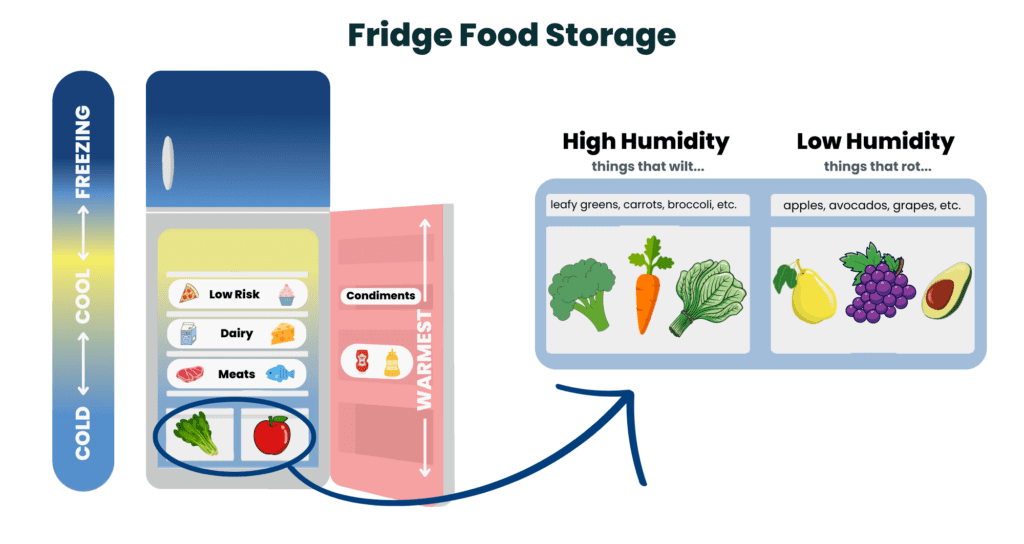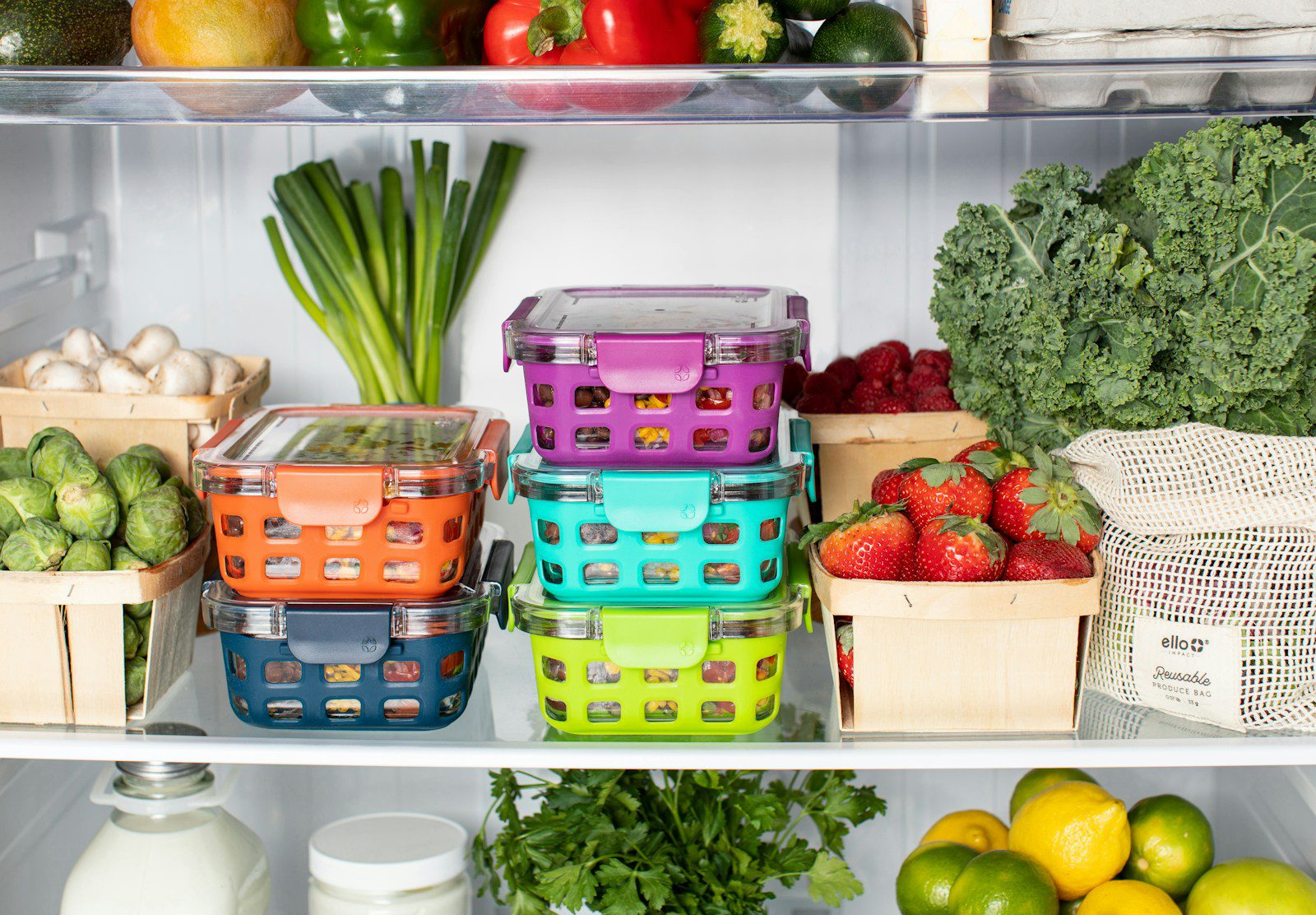Have you ever gone over to someone’s house and noticed they organize their fridge completely differently than you do? You might shrug this off as different quirks people have, but there are strategic ways to organize your food that can make a huge impact on decreasing your food waste, giving your food a longer shelf life, and saving you lots of money in the long run!
Take the Quiz:
Understanding your Fridge
Understanding your refrigerator is key to keeping your food fresh for as long as possible. Your refrigerator should be kept at about 40℉ or lower to prevent bacteria from growing (you can use an appliance thermometer to check if your refrigerator is cold enough).
Different parts of your fridge are better suited for various types of food:
- The fridge door is the warmest part of the fridge. Store condiments here, but nothing that will spoil quickly (like milk).
- The lower shelves are the coldest part of the fridge. Store meat, eggs, and dairy products here.
- The high-humidity drawer is a good place to store most vegetables, specifically leafy greens that are prone to wilting.
- The low-humidity drawer is the best place to store most fruits and any vegetables that may rot.

Fridge Storage Tips
In addition to thinking about the various temperature zones of your fridge, it’s important to consider ways you can store your food that will make it easier for you to see which food needs to be eaten first. And prepping food ahead of time can make it more likely that you’ll use it before it goes bad. Here are a few strategies you can try:
- “Eat Next” Shelf. Designate a space where you put food that is in danger of going bad and needs to be eaten asap. You can also keep a whiteboard/chalkboard/list on or near your fridge where you write down what needs to be eaten that day. (I do this while I’m making my coffee each morning).
- First In, First Out! When you’re putting away groceries, pull items you already have to the front of the shelf, or the top of the drawer (similar to how grocery stores stock their refrigerators from the back). This prevents things from getting lost in your fridge and going bad before you get a chance to enjoy them!
- Prep Now, Eat Later. Preparing perishable foods before you put them away (chopping up fruit & vegetables) can make it easier to use them in the future. (Note that prepared fruits & vegetables may spoil faster than unprepared produce, so make sure they are on the meal plan before they go bad).
Storage by Food Type
Certain fruits and vegetables can be tricky to store—here are some tips to help make your produce last longer:
- Wrap lettuce and other greens in a towel and store in a Tupperware or plastic bag (get these secondhand and reuse them many times) to keep them from wilting.
- Store cut celery and carrots upright in jars of water.
- Wash berries before eating—not before storing—to prevent mold from growing. Trapped moisture is one of the main factors that leads to mold, so do not store berries in air-tight containers. Instead, choos containers that allow ventilation. If you have space, spreading berries out on a plate or platter and then putting them in the fridge will help prevent mold as well. Note: some people soak their berries in vinegar or hot tap water before storing to get rid of bacteria. If you go this route, just make sure to dry your berries completely before you put them away.
- Fruits like bananas and tomatoes emit ethylene which can cause nearby produce to ripen (and potentially spoil) quicker. Keep them at room temperature, and away from other fruit and produce.
- Onions, garlic, and potatoes should be stored in a cool, dry place (outside of the fridge). However, onions and potatoes should be stored separately, since the ethylene from the onions causes potatoes to spoil, and the moisture from the potato causes onions to spoil.
- To prevent molding, keep bread in a cool, dry place—like your cupboard or a bread box, rather than the fridge.
- Check out Save the Food’s Interactive Storage Guide to see if there is any other food item you could be storing more effectively.
ACTION ITEM: Now that you’ve learned about food storage, take a look in your fridge and do a quick audit. Which foods are often going bad before you get to them? Could they be stored differently or in another part of the fridge? Join our food waste challenge to submit your answer and get personalized feedback!
Freezing
Using your freezer is an easy way to preserve food before it goes bad. Most foods are able to be frozen indefinitely—though the quality may decrease after being frozen for long periods of time. Frozen food should be thawed in the fridge, microwave, or in cold water. Make sure to label the contents of your freezer with the date to make sure you are eating them before they lose quality. This resource from the New York Times breaks down how long food can be frozen for best quality.
Here are some tips on optimal freezing conditions:
- Meat & seafood can be frozen for up to 6 months. Freeze in an airtight container.
- Bread can be frozen for 3 months. It is most convenient to slice bread prior to freezing—frozen slices can be toasted directly from the freezer.
- Remove eggs from their shells before freezing, and they can be stored for up to 12 months.
- Frozen fruit is best used in smoothies or cooked dishes, as most will lose their texture upon thawing. For best results, slice fruit before freezing.
- Most vegetables—including spinach, kale, mushrooms, and squash—are best cooked before being frozen, but vegetables like onions, bell peppers, and tomatoes can be frozen raw (slice or dice beforehand). Herbs should be blended with some oil prior to freezing since they do not thaw well when frozen fresh.
Pickling
Pickling is a delicious method of preserving vegetables when you have more than you can use fresh. While it may seem complicated, there are some quick & easy pickling methods you can do at home!
- Pickled Red Onions. Just combine vinegar, water, salt, and sugar to make an easy pickling brine. Pour over your sliced onions & store in the fridge for a few days before enjoying.
- Reusing Pickle Brine. If you’re new to pickling (or just don’t feel like making your own brine), try adding veggies to an old jar of pickles
CANNING
Canning is a bit more intensive than freezing or pickling, but can be a really fun hobby. Canning food prevents the growth of unwanted microorganisms & bacteria, and the vacuum seal prevents any moisture loss. If you’re interested, check out this guide to canning!
Extra Resources:
- By storing your food correctly, you are preserving it in a much healthier way and reducing the needs for preservatives. Preservatives can be an environmental justice issue, as many, such as parabens, can be endocrine disruptors, a type of chemical that influences the body’s hormones. People of color and women are disproportionately impacted by these chemicals. Learn more here.
- For easy access to food storage tips, download the FoodKeeper App (available for Android & Apple devices).
- Want some ideas for organizing your cupboards? Check out episode 21 of the Plan to Eat podcast: Food Storage — Clean Out & Organize your Cupboards!
Extra Resources:
- By storing your food correctly, you are preserving it in a much healthier way and reducing the need for preservatives. Learn about potential health and environmental justice impacts of preservatives here.
- For easy access to food storage tips, download the FoodKeeper App (available for Android & Apple devices).
- Want some ideas for organizing your cupboards? Check out episode 21 of the Plan to Eat podcast: Food Storage — Clean Out & Organize your Cupboards!
Research and content contributions from Bailee Duke and Sofia Berkowitz
SUMMER GAME CODE: CANNING

